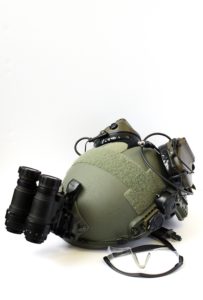
When you start looking at helmets, which I covered in part 1 of this series, you should to start looking at hearing protection.
Even if your SWAT team already has hearing protection, it is a good idea to at least consider your future hearing protection/communication needs so that you do not buy a helmet that is contrary to your current and future requirements.
A good helmet and hearing protection combination can be very comfortable. A bad combination can be pure hell (not kidding).
The Importance of Good Hearing Protection
I was on a SWAT call out several years ago and was unlucky enough to have a diversionary device (flash-bang) go off pretty much next to my head.
The flash-bang deployment had been predetermined so I knew it was coming. It was not however, part of the plan to have the bang go off next to my head.
When the flash-bang went off, it rocked my world.
If I had not been wearing a good set of hearing protection, I know I would have had to come off of the position that I was holding and I would have suffered some level of hearing damage.
Hearing Protection In General
Just like you want a comfortable helmet, you want your hearing protection to be comfortable.
You may also want to consider the following features at a minimum:
• Sound amplification
Makes the sounds around you louder
• Electronic sound reduction
Sounds over a certain decibel rating are cut out to protect your hearing
• Hear thru
If the batteries in the headset die, the radio can still be heard by the wearer
• Modularity
Individual parts be easily replaced by the user or must the entire unit be sent to the manufacturer
• Automatic shut off
Unit will power down after x amount of time without user input, but gives an audible warning before doing so
Most major manufacturers offer the above features, but you should check to see if the model you are interested in has them.
Quick Points on Hearing Protection / Communication Systems
• Remember it is a hearing protection and a communication system. Whatever design you go with, it needs to provide hearing protection and work well as a communication system
• Hearing protection that has a behind the neck mount/hardware can be more difficult to wear with some types of helmet strap systems. Evaluate helmets and hearing protection at the same time.
• Some over- the-head type systems are less comfortable with MICH/ACH helmets because the side of the helmet can squeeze the headset which in turn crushes the user’s head.
• Gel cups (the portion that surrounds your ear) provide the best sound dampening seal (critical to good hearing protection) even with eye protection on and tend to be more comfortable.
• I have used in-ear (think ear buds) and over the head hearing protection/comms systems.
The in-ear systems work really well, but they are less durable than over-the-head style systems. Remember, what you buy needs to last for years, not a year.
• Helmet rail mounted hearing protection is infinitely more comfortable than over the head ear protection. Check out ARC rail adapters
• *REMEMBER* If you go with ARC rail mounted comms or a similar style you will have to wear your helmet whenever you need to use your comms.
Depending on your SOPs, entry guys who double as snipers need to consider how they will run comms and have hearing protection. In an enclosed space that .308 sniper rifle is really loud…
• Make sure that push-to-talk button is easy to use while wearing gloves and while under stress.
• Don’t forget to talk to your department’s communication people. Your agency may have plans to upgrade its radio system or buy different portables.
Chances are the new portable radios are not going to be work with the same cable you are using for your evaluation.
Specifically Team Leaders and Assistant Team Leaders
• Look at a dual radio capable system, even if team leadership does not use dual comms. If your needs change down the road, all you will need is a second cable.
• If you go with the dual radio comms try to get a system that dedicates one ear (say the left ear) to one radio and the other ear to the second radio.
It can get confusing knowing which channel is talking if both signals are played in both ears.
• If the option is available consider a cell phone cable adapter. It beats taking off your helmet then comms to talk on the phone.
• *REMEMBER* If you go with ARC rail mounted comms or a similar style, you too will have to wear your helmet whenever you need to use your comms.
This is important if you often find yourself off the target location, geared down, and coordinating with other leadership.
Wrap Up
That covers hearing protection in the broad strokes.
The big take away to remember is that it is a hearing protection and communication system.
Take your time, consider your team’s needs, and plan for future capacities. Then do your research and make a selection.
You want to buy a system that increases your team’s capabilities, not takes away from them.
Part 3 of this series will cover night vision.
